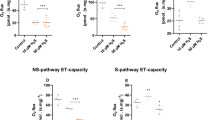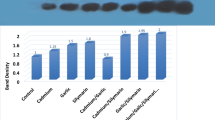Abstract
Ascorbate treatment 30 min prior to sodium dichromate (20 or 30 mg/kg, s.c.) shows higher potency than that of glutathione (GSH) in protecting against both the metabolic disturbance and nephrotoxicity induced by dichromate. However, ascorbate treatment after 2 h of dichromate intoxication had no effect on dichromate-induced blood urea nitrogen (BUN) elevation 3 days after intoxication. In contrast, dichromate-induced glucosuria, which reached maximum levels at 3 days after treatment, was significantly decreased by GSH or N-acetyl cysteine (NAC) treatment, even if its administration was after 24 h of dichromate intoxication. Pretreatment with GSH depletors such as diethyl maleate (DEM) and buthionine sulfoximine (BSO) had no effect on dichromate-induced nephrotoxicity. GSH levels in the liver and kidney were not affected at 3 h after dichromate treatment. However, dichromate significantly increased tissue GSH levels with a marked increase in liver per kidney GSH ratio at 24 h after treatment, if food was withheld subsequent to dichromate treatment, indicating that GSH biosynthesis resulted from the accelerated protein breakdown. These results suggest that GSH-mediated dichromate reduction is not a kinetically favorable pathway in vivo; however, GSH plays an important role in protection against dichromate-induced nephrotoxicity. In addition, the cellular metabolism of dichromate in the early period after treatment is important in the pathogenesis of its nephrotoxicity.
Similar content being viewed by others
References
Baines AD (1965) Cell renewal following dichromate induced renal tubular necrosis. Am J Pathol 47: 851–876
Banks RB, Cooke RT (1986) Chromate reduction by rabbit liver aldehyde oxidase. Biochem Biophys Res Commun 137: 8–14
Banner W, Koch M, Capin DM, Hopf SB, Chang S, Tong TG (1986) Experimental chelation therapy in chromium, lead, and boron intoxication with N-acetyl cysteine and other compounds. Toxicol Appl Pharmacol 83: 142–147
Berndt WO (1975) The effect of potassium dichromate on renal tubular transport processes. Toxicol Appl Pharmacol 32: 40–52
Biber TUL, Mylle M, Baines AD, Gottschalk CW, Oliver JR, Mac-Dowell MC (1968) A study by micropuncture and microdissection of acute renal damage in rats. Am J Med 44: 664–705
Borges KM, Wetterhahn KE (1989) Chromium cross-links glutathione and cysteine to DNA. Carcinogenesis 10: 2165–2168
Capellmann M, Bolt HM (1992) Chromium(VI) reducing capacity of ascorbic acid and of human plasma in vitro. Arch Toxicol 66: 45–50
Christenson WR, Davis ME, Berndt WO (1989) The effect of combined treatment with potassium dichromate and maleic acid on renal function in the rat. Toxicol Lett 49: 21–27
Connett PH, Wetterhahn KE (1983) Metabolism of the carcinogen chromate by cellular constituents. Structure and Bonding 54: 93–124
Connett PH, Wetterhahn KE (1985) In vitro reaction of the carcinogen chromate with cellular thiols and carboxylic acids. J Am Chem Soc 107: 4282–4288
Cupo DY, Wetterhahn KE (1985) Modification of chromium(VI)-induced DNA damage by glutathione and cytochrome P-450 in chicken embryo hepatocytes. Proc Natl Acad Sci 82: 6755–6759
De Flora S, Morelli A, Basso C, Romano M, Serra D, De Flora A (1985) Prominent role of DT-diaphorase as a cellular mechanism reducing chromium(VI) and reverting its mutagenicity. Cancer Res 45: 3188–3196
Evan AP, Dail WG (1974) The effects of sodium chromate on the proximal tubules of the rat kidney; fine structural damage and lysozymuria. Lab Invest 30: 704–715
Gray SJ, Sterling K (1950) The tagging of red cells and plasma proteins with radioactive chromium. J Clin Invest 29: 1604–1613
Gruber JE, Jennette KW (1978) Metabolism of the carcinogen chromate by rat liver microsomes. Biochem Biophys Res Commun 82: 700–706
Hirsch GH (1973) Differential effects of nephrotoxic agents on renal organic ion transport and metabolism. J Pharmacol Exp Ther 186: 593–599
Hojo Y, Sugiura Y, Tanaka H (1977) Chromium(III)-penicillamine complex; some properties and rapid chelation from chromium(VI) and penicillamine. J Inorg Nuc Chem 39: 1859–1863
Jones RE (1990) Hexavalent chrome; threshold concept for carcinogenicity. Biomed Environ Sci 3: 20–34
Kaplowitz N, Aw TY, Ookhtens M (1985) The regulation of hepatic glutathione. Annu Rev Pharmacol Toxicol 25: 715–744
Kawanishi S, Inoue S, Sano S (1986) Mechanism of DNA cleavage induced by sodium chromate(VI) in the presence of hydrogen peroxide. J Biol Chem 261: 5952–5958
Kim E, Na KJ (1990) Acute toxic effect of sodium dichromate on metabolism. Arch Toxicol 64: 644–649
Kim E, Na KJ (1991a) Effect of sodium dichromate on carbohydrate metabolism. Toxicol Appl Pharmacol 110: 251–258
Kim E, Na KJ (1991 b) Nephrotoxicity of sodium dichromate depending on the route of administration. Arch Toxicol 65: 537–541
Koutras GA, Schneider AS, Hattori M, Valentine WN (1965) Studies on chromated erythrocytes; mechanisms of chromate inhibition of glutathione reductase. Br J Haematol 2: 360–369
Norseth T, Alexander J, Aaseth J, Langard S (1982) Biliary excretion of chromium in the rat: a role of glutathione. Acta Pharmacol Toxicol 51: 450–455
Reed DJ (1989) Glutathione and vitamin E in protection against mutagens and carcinogens. In: Taylor SL, Scanlan RA (eds) Food toxicology; a perspective on the relative risks. Marcel Dekker, Inc., New York, pp 169–203
Rossi SC, Wetterhahn KE (1989) Chromium(V) is produced upon reduction of chromate by mitochondrial electron transport chain complexes. Carcinogenesis 10: 913–920
Ryberg D, Alexander J (1984) Inhibitory action of hexavalent chromium(Cr(VI)) on the mitochondrial respiration and a possible coupling to the reduction of Cr(VI). Biochem Pharmacol 33: 2461–2466
Samitz MH, Scheiner DM, Katz SA (1968) Ascorbic acid in the prevention of chrome dermatitis. Arch Environ Health 17: 44–45
Sasame HA, Boyd MR (1978) Paradoxical effects of cobaltous chloride and salts of other divalent metals on tissue levels of reduced glutathione and microsomal mixed-function oxidase components. J Pharmacol Exp Ther 205: 718–724
Sedlak J, Lindsay RH (1968) Estimation of total, protein-bound, and nonprotein sulfhydryl groups in tissue with Ellman's reagent. Anal Biochem 25: 192–205
Standeven AM, Wetterhahn KE (1991a) Possible role of glutathione in chromium(VI) metabolism and toxicity in rats. Pharmacol Toxicol 69: 469–476
Standeven AM, Wetterhahn KE (1991 b) Ascorbate is the principal reductant of chromium(VI) in rat liver and kidney ultrafiltrates. Carcinogenesis 12: 1733–1737
Sugiyama M, Tsuzuki K, Ogura R (1991) Effect of ascorbic acid on DNA damage, cytotoxicity, glutathione reductase, and formation of paramagnetic chromium in Chinese hamster V-79 cells treated with sodium chromate(VI). J Biol Chem 266: 3383–3386
Suzuki Y, Fukuda K (1990) Reduction of hexavalent chromium by ascorbic acid and glutathione with special reference to the rat lung. Arch Toxicol 64: 169–176
Tateishi N, Higashi T, Shinya S, Naruse A, Sakamoto Y (1974) Studies on the regulation of glutathione level in rat liver. J Biochem 75: 93–103
Tsapakos MJ, Wetterhahn KE (1983) The interaction of chromium with nucleic acids. Chem Biol Interact 46: 265–277
Wiegand HJ, Ottenwälder H, Bolt HM (1985) The formation of glutathione-chromium complexes and their possible role in chromium disposition. Arch Toxicol Suppl 8: 319–321
Wolf T, Bolt HM, Ottenwälder H (1989) Nick translation studies on DNA strand breaks in pBR322 plasmid induced by different chromium species. Toxicol Lett 47: 295–301
Author information
Authors and Affiliations
Rights and permissions
About this article
Cite this article
Na, K.J., Jeong, S.Y. & Lim, C.H. The role of glutathione in the acute nephrotoxicity of sodium dichromate. Arch Toxicol 66, 646–651 (1992). https://doi.org/10.1007/BF01981504
Received:
Accepted:
Issue Date:
DOI: https://doi.org/10.1007/BF01981504




